- 0 No item in your cart
- The magazine

Current issue
- All the issues
- My magazines
- Technical specifications
- Multihull of the Year
- Classified Ads
- Destinations
- Online store
- All the magazines
- Subscriptions
- Accessories

Practical info
- Builder : CN PHILIPPE
- Test of theTribellule
- Finance your Tribellule
- Articles about the Tribellule
Specifications
Rigging and sails, technical specs from this builder.
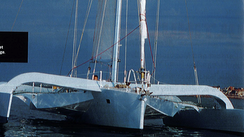
What readers think
Post a comment
No comments to show.
Useful links
MW #197 - Oct / Nov 2024
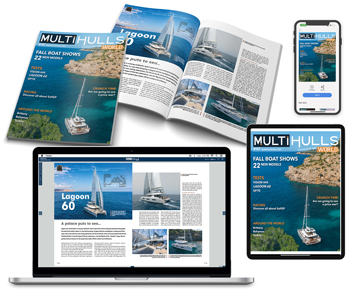
The Complete Boat Tests
Almost 40 years of boat tests!
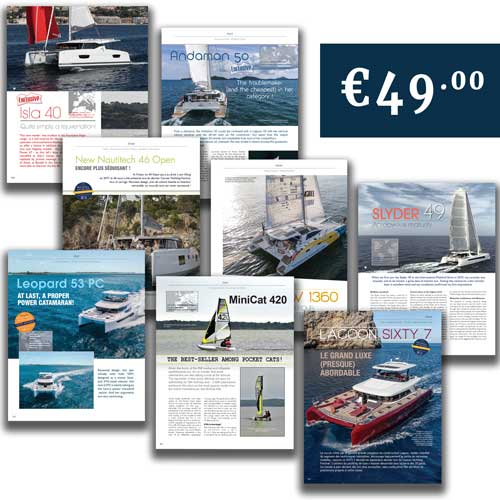
Classified ads

Woods Flica 35
Bosgraaf 15m trimaran, minicat 310.

Nautitech 48 0pen Available
Vous avez ajouté " " à vos favoris., vous avez supprimé " " de vos favoris., in order to add this article to your favorites, please sign in..
- 0 Aucun produit au panier
Numéro en cours
- Tous les numéros
- Mes magazines
- Multicoques
- Fiches techniques
- Multihull of the Year
- Petites annonces
- Destinations
- Cartes postales
- Tous les magazines
- Abonnements
- Accessoires

Essai tiré du Multicoques Mag #93 (juin/juillet 2002)
Le Tribellule n'est vraiment pas un multicoques de voyage comme les autres. Tout d'abord, il s'agit d'un trimaran, et le fait est suffisamment rare pour être souligné. Ensuite, il est réalisé en aluminium. Par une journée d'automne, entre Lorient et Groix, nous sommes allés l'essayer. Impressions...
Partager cette page
Infos pratiques.
- Le chantier : CN PHILIPPE
- La fiche technique
- Financez votre Tribellule
- Articles autour du Tribellule
Prix de l'essai 5.00 €

Ajoutez plusieurs essais au panier
et bénéficiez d'une réduction !
Se connecter
Pour lire la suite achetez l'essai, les avis des lecteurs.
Postez un avis
Il n'y a aucun commentaire.
MM n°226 - Sept / Oct 2024
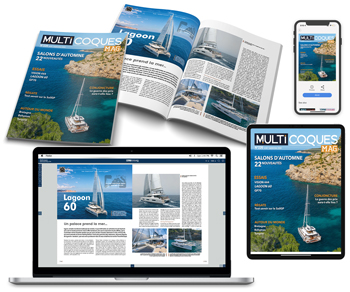
Téléchargez l’intégrale des essais
Plus de 500 essais de Catamarans et Trimarans
Publiez une annonce Gratuitement
sur Multicoques Magazine
Essais des bateaux de la même gamme

- NEEL 43 Performance

Libertist 853 - Version repliable
- Libertist 853 - Folding Version

- Neel 45 Evolution
Les petites annonces

Woods Flica 35
Bosgraaf 15m trimaran, très bon état minicat 310.

Nautitech 48 0pen Disponible
Vous avez ajouté " " à vos favoris., vous avez supprimé " " de vos favoris., pour ajouter cet article à vos favoris, veuillez vous connecter..

Search boats for sale
CNA Tribellule 44.2 (sailboat) for sale

Boat data CNA Tribellule 44.2
Technical data, buy cna tribellule 44.2 - equipment sailing catamaran - sailboat for sale, cna tribellule 44.2 - info without obligation - sailing catamaran.

Other boats (like CNA Tribellule 44.2) - for buy and for sale

Grand Soleil 43
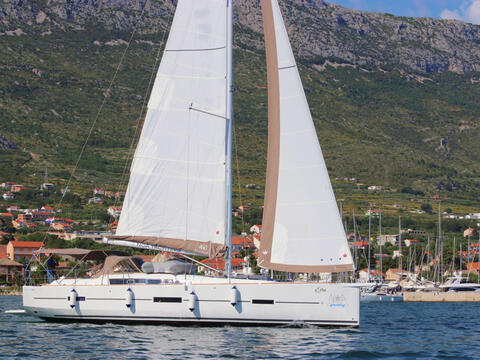
Dufour 460 Grand Large

Jeanneau Sun Odyssey 440

Gibert Gib'Sea 48 Master
These sailboats could also be of interest to you.

- Fiche technique
- Bateaux �quivalents
Trilibellule 44
Fiche technique du trilibellule 44.

Voir la fiche technique
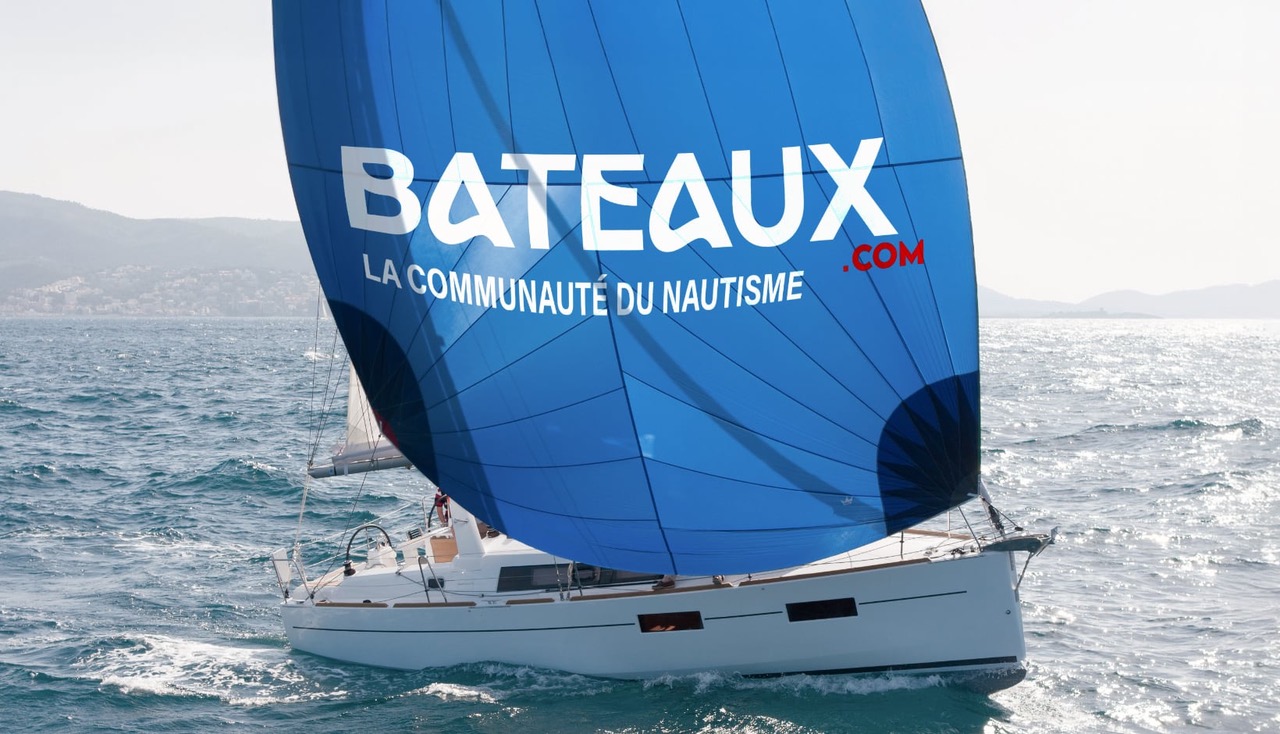
2 mod�les de bateaux
CN Philippe
Bateaux de l'architecte Claude Philippe
CNA Yachting
- Used motorboats
- Used sailboats
- All used boats
- New motorboats
- New sailboats
- All new boats
- Boat brands
- Boat models
- Boats ad visibility booster pack
- Boat quotation
- Frequently asked questions

CNA TRIBELLULE 44.2
Information about the boat, living on board, ad information, key features, description, maintenance, electronics, interior equipment, outdoor equipment, do you like the cna tribellule 44.2 model also discover:.
- Loading... Loading... 13 0 LOUISIANE 37 1984 Secondhand Fiumicino, Italy Total length : 11.1m Beam : 6m Material : Other Number of cabins (except saloon) : 2 Total number of berths : 6 €69,000 incl. VAT Pro T.Y. Broker Srls Professional
- Loading... Loading... 13 0 MATTIA 39 1980 Secondhand Bastia, France Total length : 11.7m Beam : 4.8m Material : Glass-Reinforced Plastic (GRP) Number of cabins (except saloon) : 3 Total number of berths : 8 €55,000 incl. VAT Pro XBOAT Professional
- Loading... Loading... 29 0 PROUT 37 SNOWGOOSE ELITE 1986 Secondhand PORT-SAINT-LOUIS-DU-RHONE, France Total length : 11.28m Beam : 4.85m Number of cabins (except saloon) : 4 Total number of berths : 8 €77,000 incl. VAT Pro CAP OCEAN Professional
- Loading... Loading... 15 0 FOILER 50 1983 Secondhand CARIBBEAN, Sint Maarten Total length : 15.24m Beam : 11.89m €70,000 excluding tax Pro HAREL YACHT BROKER Professional
Yachting Monthly
- Digital edition

Wow, that was fast! Why trimarans are SO much fun to sail – and how to do it
- Theo Stocker
- February 13, 2024
For their size, trimarans can punch well above their weight in speed, cruising potential and fun. Monohull sailor Theo Stocker gets to grips with how to handle one
Humans tend to gravitate into tribes of like-minded enthusiasts, enjoying the encouragement, support and sense of identity, while often looking askance at others; sailors at motorboaters, cruising sailors at racers, monohull sailors at raft, I mean, multihull sailors, and everyone looks askance at jet-skiers.
Large cruising catamarans (40ft now counts as a small one) are a world apart from monohull sailing, but there’s a sub-tribe of sailors dedicated to life on three hulls and builders such as Dragonfly, Corsair, Farrier, and Astus give them plenty of choice.
I’ve been sailing a 22ft (7m) Astus 22.5 this season, with just enough space for a family of four and a minimum of creature comforts. Thanks to her VPLP-designed hulls and 650kg all-up weight, we can sail upwind at 7-plus knots and downwind at over 10 knots with ease, all on a roughly even keel, while the kids play Duplo down below. It can also be beached and is towable behind a car.
Having, it seems, caught the trimaran bug, I wanted to get better at sailing and handling the boat, but my monohull sailing experience and habits were proving something of a hindrance, so we sought advice from some existing trimaran owners, and well as the UK’s top multihull sailors.
Much of the advice will apply to all multihulls , whether two or three-hulled, while other parts are just for small trimarans. I also found that brushing-up some of my rusty dinghy sailing skills helped get my head around what we were trying to do.
To try out our expert tips we went out sailing to see what difference they made. On the day, we got a solid Force 4-5 southwesterly, averaging 16 knots, but fluctuating between 12 and 20 knots true.
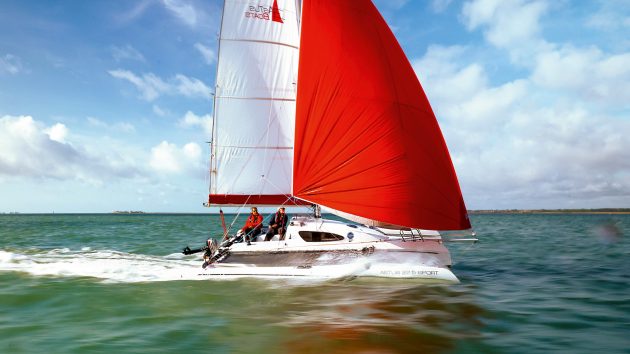
Blasting about on a sporty trimaran is a whole world of fun, but is much calmer than it looks
Trimaran sail trim
One of the biggest differences between a cruising monohull and a multihull is how the mainsail is trimmed. Leech tension on a yacht is often largely controlled by the kicker and the backstay, while the mainsheet sheets the mainsail in and out, predominantly controlling the angle of the boom to the centreline, and there may be a short traveller.
On a mulithull, however, there’s more than enough space for a good, wide traveller. Those who sail on performance monohulls will also be used to this. The sail shape is mainly controlled by the mainsheet, and the traveller then moves the boom towards or away from the centreline.
This is exaggerated on a multihull which has wide shrouds, swept well aft with no backstay, making space for a powerful square-top mainsail with full-length battens. There’s no backstay to bend the mast and flatten what is anyway a pretty rigid mainsail.
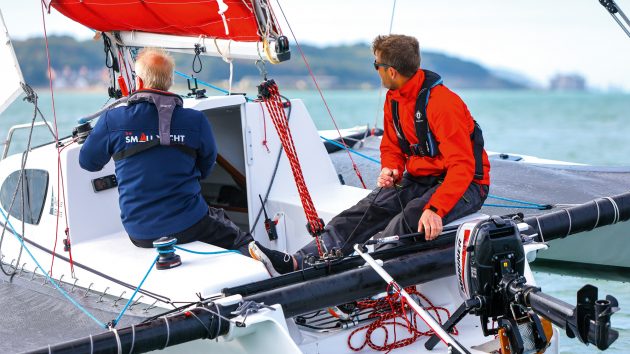
The mainsheet purchase creates enough power to control the leech of the square-top mainsail
Depowering a trimaran
Sailing on a monohull, heel and weatherhelm and eventually a broach give loads of warning that you’re pushing too hard. With straight hulls and little heel, those warning signs don’t really apply to multihulls.
In reality, however, there are a host of warning signals that it’s time to back-off; they’re just a bit different. Even then, there’s still a large safety margin before you get close to danger.
By way of reassurance, with the boat powered up on a beat, Hein, from Boats on Wheels, the boat’s owner, stood on the leeward hull and lent on the shrouds. Even as his feet got wet and the wind gusted at the top of Force 4, the boat didn’t bat an eyelid, thanks to the huge buoyancy of the floats.
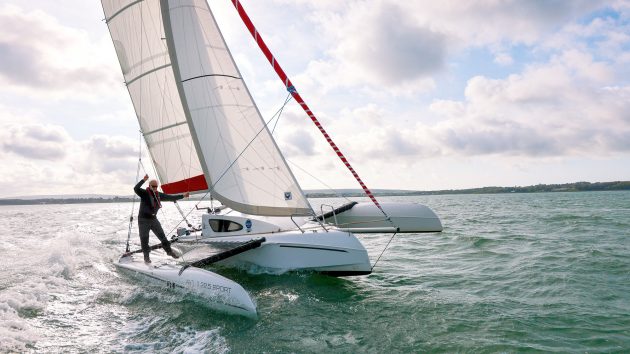
Even with a person on the leeward float the boat was extremely stable
On the water – sail trim
My first inclination was to point the boat as high upwind as possible, pin the sails in and go for height. Doing that resulted in a not-terrible boat speed of 5-6 knots and a good pointing angle.
Free off by a handful of degrees however, and ease the sails just a smidge, and the speed leapt up to 8-9 knots – over 50% more; a huge increase. So, don’t pinch. If you had a decent chartplotter on board, you could find your optimum speed to angle using velocity made good (VMG).
I was also tempted to pinch in the gusts, but it’s better to hold your course and let the speed increase until the main needs easing.
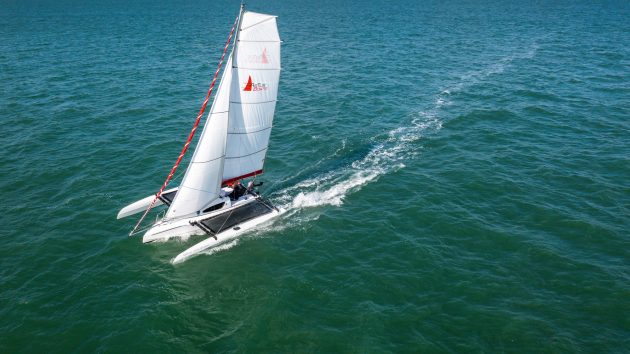
On the wind, it’s time to get the boat fully powered up
If that’s the case, drop the main down the traveller an inch or two or ease some twist into the mainsail and it makes all the difference in the world, but not so far that the top battens fall away and invert – that really isn’t fast. Push too hard and the boat will slow down, largely from the drag of submerging the leeward float and crossbeams. If you’re still overpowered and the main is luffing, it’s time to reef. Downwind is different, but we’ll get onto that later.
After we put a reef in the main, our boat speeds upwind remained largely the same, and the boat was much happier. I came away feeling reassured that even a little trimaran like this would be pretty difficult to capsize, and there were always plenty of warning signs telling me to take my foot off the pedal a little.
Article continues below…

Catamaran sailing skills: Mooring and anchoring a multihull
How do you make an average passage speed of 7 knots, fit in three double cabins and a huge saloon…

Monohull or multihull: which is best for blue water?
As former editor of Yachting World, David Glenn has plenty of experience of both monohull and multihull cruising. Here he…
Tacking and gybing a trimaran
Everyone knows that multihulls don’t tack as well as monohulls. Straight hulls and wide beam don’t lend themselves to turning, especially when coupled with the displacement and fixed keels of big cats. Trimarans are a little easier, with a single central daggerboard to act as a pivot, and one or other of the floats will generally be clear of the water. On the downside, light displacement means that there isn’t much momentum to keep you going through the turn and plenty of windage to stop you.
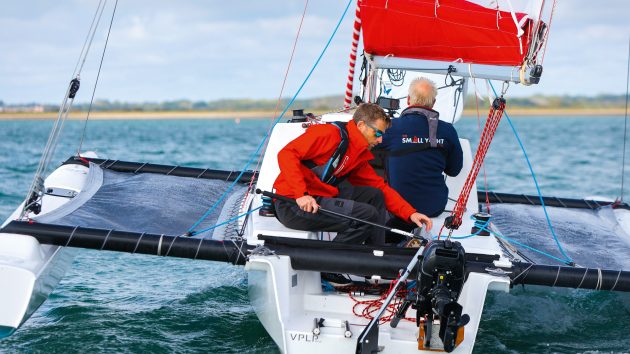
On a trimaran the central daggerboard helps the boat to turn by providing a central pivot point that catamarans lack
Speed is your friend. Build speed up before the tack to give you as much momentum as possible. The helm needs to steer positively into and through the turn, and if necessary, keep the jib backed on the new windward side to help the bow through the wind. Don’t worry about scrubbing speed off, but you don’t want to get stuck in irons.
When it comes to gybing, speed is again key. The turning bit isn’t going to be an issue as you’ll be scooting along, but the faster you’re going, the less load there will be on the sails. The more you slow down, the more the true wind will pile up.
Trimaran sailing skills
Tacks took a bit of practice. It felt plain wrong to jab the tiller across the boat, slamming a big break on in the water but I ended up putting us through the tacks far too slowly, losing a lot of speed. A more aggressive approach worked better. On the Astus, the traveller was between me and the tiller, so the tiller extension needed to be swung around the stern behind the mainsheet onto the new side.
Similarly, old habits of controlling a gybe needed to be modified. With the asymmetric set, we were planing at well over 10 knots, and the ideal is to stay on the plane. Heading dead downwind and centring the main lead to a more violent manoeuvre than flying into the gybe as fast as possible and, as the boom was never that far out thanks to the apparent wind angle, it didn’t need much extra controlling.
Coming up onto the wind after the gybe helped the asymmetric around the front of the jib and to fill on the new side. Stay too deep and it’ll get blanketed by the main. Once we had built up some apparent wind, we could bear away again.
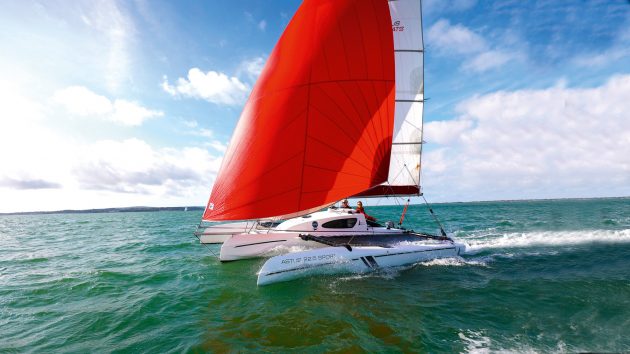
You’ll be on a course deep downwind before you know it, hitting speeds in the double digits
Downwind in a trimaran
Upwind cruising may be fun in a multihull, but bearing away and going with the wind is what it’s all about. Easily-driven hulls, a generous sailplan and light weight mean you can be up and planing, leaving displacement boats wallowing in your wake.
The big difference comes from apparent wind. If you’re in a boat that can do 15 knots downwind in 20 knots of true wind, the resulting wind angles can really mess with your head.
To get going then, says Brian Thompson, ‘Use those leech tell-tales again when sailing downwind and reaching to set the correct twist through the mainsheet, and use the traveller to set the correct angle of the whole sail to the wind.’
As the wind and your speed builds, bear away and trim the main accordingly.
In theory, you shouldn’t need to ease the traveller at all, but you may need to if you want to sail deep downwind. As the gust fades, you’ll find the boat slows down, so you can come back up towards the wind a little to pick up some more breeze, and then bear away as you accelerate again.

Bear away as the boat accelerates. Your course will be something of a slalom as you look to keep a consistent wind angle
This results in something of a ‘slalom’ course, and will also be accentuated if you’re sailing down waves, but that’s all quite normal for apparent wind sailing. Ultimately, you’re looking for a consistent apparent wind angle, even if the resulting wake isn’t straight.
It’s worth remembering that apparent wind reduces the felt effect of the wind, so you need a sailplan to suit the true, not apparent wind speed.
I found that the boat was more sensitive to having a balanced sailplan and trim downwind than upwind, largely because you’ve got almost double the canvas up, with the bowsprit as an extra lever. When weather helm built, I needed to ease the mainsheet to increase twist to depower so that I could bear away. I must admit, getting the boat balanced, sailing fast and light on the helm at 15 knots was something I came away feeling I needed more practice at.
Reviewing the images, I suspect the asymmetric was sheeted in too hard, with too much twist in the main.
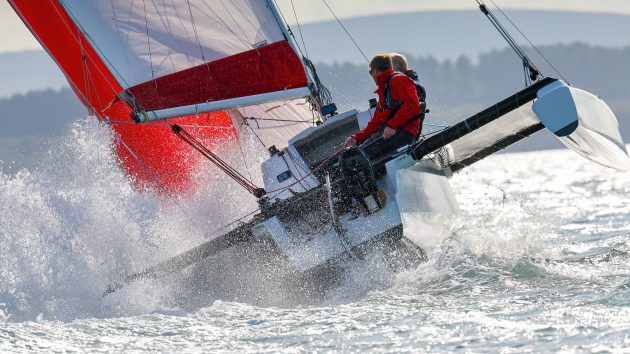
Getting a float fully submerged is when it’s time to back off
On the water
Unfurling the gennaker worked best on a beam reach, giving plenty of airflow over the sail to help it fully unfurl. This was also roughly the fastest point of sail, ideal for getting up some speed for apparent wind sailing. We mostly had the sails set for a close reach, even when we were beyond 120º off the true wind on a broad reach.
It was possible to soak deeper downwind, but lose the apparent wind benefit downwind and our speed dropped off dramatically, prompting us to point a bit higher to find some more speed.
As the boat powered up, it paid to hold a slightly higher angle than I would have done in a monohull for the boat to properly take off and get up into double digit speeds – topping out at 15 knots. Lymington to Cowes would have taken us just half an hour at that speed. It’s easy to give yourself a heck of a beat back!
We were sailing on a pretty flat day, so didn’t have to contend with any waves to speak of. On the recent RTI this is what caused the capsizes of at least two multis, a sobering reminder that you need to sail much more conservatively in lumpier conditions.
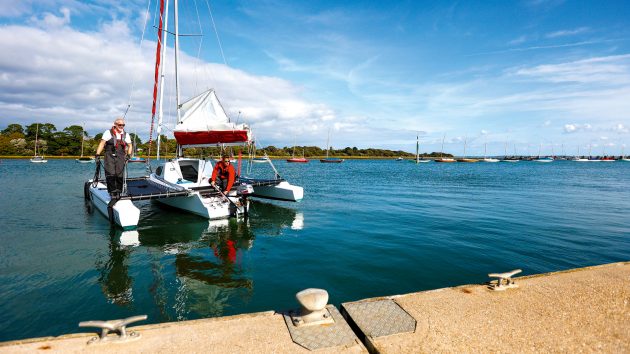
The bows want to point downwind, so a stern-first approach works with rather than against the boat
Coming alongside
A 650kg boat with no draught and plenty of windage feels dreadfully skittish when manoeuvring in confined spaces. Straight hulls with no forgiving curves and fragile-looking sharp bows make berthing tricky. You’ve got a couple of advantages on your side, however. In the Astus, the floats are at pontoon height making stepping off easy.
Whether you have an engine in each hull of a cat, or one in the central hull of a tri, there’s also a lot more leverage to play with to turn the boat and drive her on or off the pontoon. A steerable outboard gives you even more options.
If the boat has a lifting keel or daggerboards, put them down if there’s enough depth to give you a pivot and to resist drifting. Think about getting corners onto the pontoon, rather than putting the boat alongside. On tris, you won’t be able to get to the bow to fend off as it’s too narrow. You can rig a fender up forwards on a line, and two fenders are enough on the flat sides.
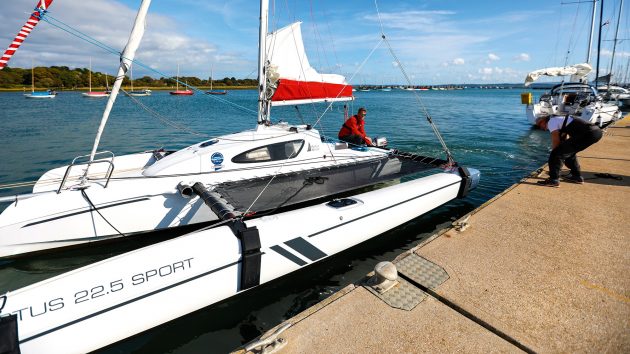
Steering with the outboard towards the pontoon will drive the stern in more; steer away to drive the bow in more
Offshore wind
Coming onto the pontoon with wind blowing off, it worked well coming in stern first. If there’s a tide running, you’ll want to be heading into the tide, so find a spot down wind and down tide to start your approach so you come in at an angle.
On our first attempt we had a bit of tide under us to start with so we came in at a much steeper angle, almost 90º, although this worked out OK in the end.
The crew could then step ashore, taking a line from the stern quarter round a cleat.
Drive forwards against the line and the bow will obediently drive up towards the pontoon, bringing you flat alongside. Getting off was simple, releasing the bowline, and allowing the bow to swing out the before slipping the stern line.
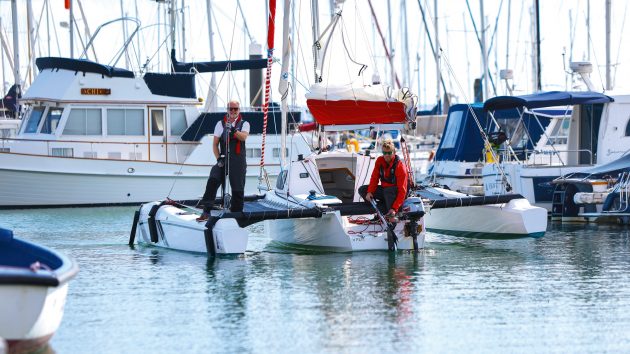
Coming in astern and stopping upwind of the berth meant the bows blew towards the pontoon far to quickly
Onshore wind
Getting onto and off a pontoon with onshore wind proved rather trickier. On our first attempt we came in stern first. The issue was that once we were just upwind of our desired berth and stopped, we lost steerage and the bow immediately blew off with alarming speed towards the pontoon.
Going ahead would only increase the force of the impact, while going astern only increased the bow’s sideways drift. I managed to back out without smashing the bow, but only just, and ended up awkwardly stern to the wind with the bows pointing at the pontoon.
On our second attempt we came in bows first but having aimed at the berth, I had to motor the stern to leeward to stop the bow hitting, making for a rather forceful coming alongside.
On take three, I came in forwards and began ferry gliding towards the berth early, keeping the bows to windward of the stern. Being able to steer with the outboard meant I could go ahead to keep the bow up, and go astern with the engine pulling the stern down toward the pontoon. In this way, it was possible to come in pretty well controlled and parallel to the berth.
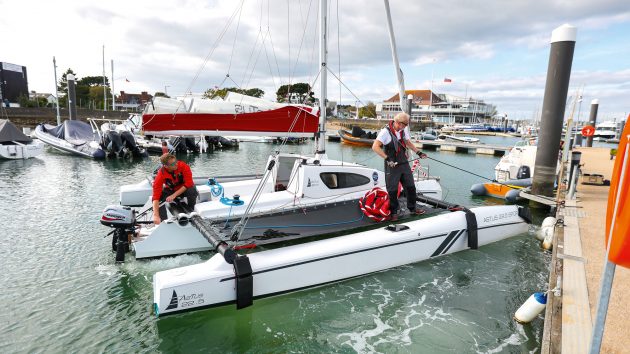
To get out, motoring astern against a bow line pulled the entire boat clear before slipping the line
Leaving was a different proposition all together, as I didn’t want to drag the bow along the pontoon, or to drive hard onto it to spring off. Instead, we rigged a slip-line from the forward cross beam. Going astern against this, and then turning the engine towards the wind, I could pull the stern, and the rest of the boat, out and away from the pontoon.
Keeping power on astern, once we’d reached a decent angle, we slipped the line and went astern, finding steerage way almost at once, with the bow following obediently in our wake with more control than I had anticipated.
Whether the wind is blowing onto, or off the pontoon, you want the engine to be driving or pulling the boat off the pontoon with a line on the corner you are going away from. That way you avoid point-loading fine ends where it’s hard to fender.
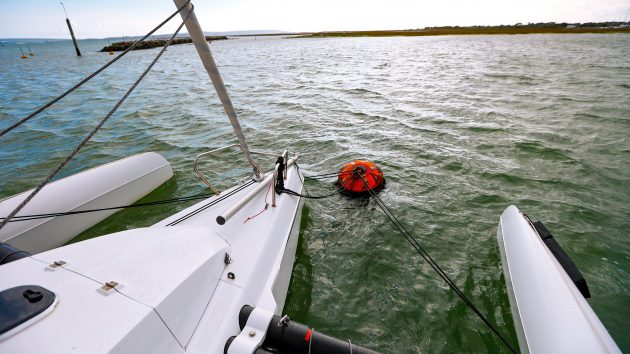
You’ll want a bridle to reduce swinging, but keep the pick up lines on the bow as backup
Anchoring and mooring a trimaran
While mooring a catamaran is complicated by the lack of a central bow, things should be simpler on a trimaran, and they are, mostly. Picking up a mooring buoy from the main hull bow with a low freeboard and dropping the pick-up line onto a cleat is easier even than a monohull.
The bow may be narrow, but for any lines that pass through a ring on the buoy, you still need to take it back to the same cleat to avoid chafe. That should be it, but windage from the two extra bows and the lack of keel mean the boat can dance merrily around the mooring buoy in a breeze.
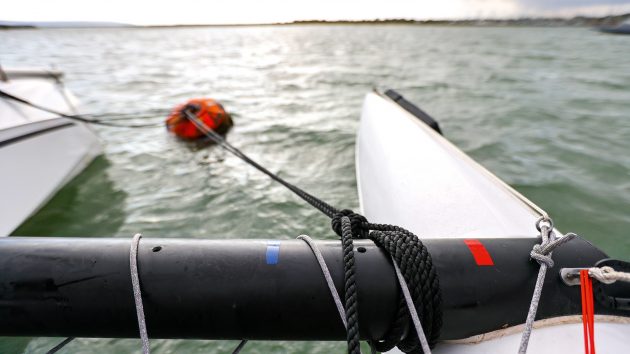
Rig the bridle so the buoy sits to one side to stabilise the boat
In practice, we found that a trimaran benefits from a mooring bridle in the same way that a catamaran does. It can’t be rigged from the floats’ bows, as there are no mooring cleats, so a line passed around the outboard ends of the forward beams gave a pretty good angle, again with long lines passed through the mooring and back to the same side. The main pick-up lines stay as a safety backup.
The other trick is to rig the bridle asymmetrically so that the buoy sits to one side or the other, just enough to not be dead head to wind, making it much more stable in the wind.
On the plus side, the lack of draught or keel means that you’ll nearly always be lying head to wind, so the cockpit remains nice and sheltered whatever the tide’s doing.
We ran out of time on the day to try anchoring, but rigging a bridle, effectively a long snubber to a point on the anchor chain in a similar way wouldn’t be tricky.
If you needed not to swing, or to behave more like deeper boats nearby, hanging a bucket over the stern can help, or there’s always anchoring with a kedge, either out ahead in a V, or in line astern.
Enjoyed reading this?
A subscription to Yachting Monthly magazine costs around 40% less than the cover price .
Print and digital editions are available through Magazines Direct – where you can also find the latest deals .
YM is packed with information to help you get the most from your time on the water.
- Take your seamanship to the next level with tips, advice and skills from our experts
- Impartial in-depth reviews of the latest yachts and equipment
- Cruising guides to help you reach those dream destinations
Follow us on Facebook , Twitter and Instagram.
Log in or Sign up
You are using an out of date browser. It may not display this or other websites correctly. You should upgrade or use an alternative browser .
Aluminium 55' fast cruising trimaran
Discussion in ' Boat Design ' started by Two Bob Peter , Jul 8, 2017 .
Two Bob Peter Junior Member
Hi All New poster, experienced sailor, looking to build a fast cruising trimaran in aluminium. Similar design basis as Chris White Hammerhead 54 or Rapido 60. Plan is to commence construction approx 3 years time. Fabricate hulls at my factory (aluminium fabrication business) in Australia and then do fitout in SE Asia. Havent got a huge budget, but from experience I believe I have a good grasp of how much a venture of this size is going to cost. Looking to discuss plans, design etc with architect / engineers that may have done something like this before. Cheers, Peter

JSL Senior Member
Two Bob Peter said: ↑ Hi All New poster, experienced sailor, looking to build a fast cruising trimaran in aluminium. Similar design basis as Chris White Hammerhead 54 or Rapido 60. Plan is to commence construction approx 3 years time. Fabricate hulls at my factory (aluminium fabrication business) in Australia and then do fitout in SE Asia. Havent got a huge budget, but from experience I believe I have a good grasp of how much a venture of this size is going to cost. Looking to discuss plans, design etc with architect / engineers that may have done something like this before. Cheers, Peter Click to expand...
Alik Senior Member
Quite new to trimarans, but have done plenty of cats, also a lot of boats in alu - all with cutting files, to ISO/CE standards. Launched Boats and Catamarans Designed by AM Design, Thailand http://amdesign.co.th/Launched.html
Ad Hoc Naval Architect
Two Bob Peter said: ↑ New poster, experienced sailor, looking to build a fast cruising trimaran in aluminium. .. Click to expand...
JSL said: ↑ Why not contact Chris white? Click to expand...
Ad Hoc said: ↑ What is your SOR that lead you to dictate the hull form as a Trimaran from the outset? Click to expand...
Nico Crispi Junior Member
Hello Peter. If nothing else you MUST read this book: https://www.amazon.com/Case-Cruisin...877421005/ref=mt_hardcover?_encoding=UTF8&me=
petebrown New Member
Hi, I'm in Oz also and interested in these types of trimarans - just wondering if you are still pursuing this ? cheers pete
Hi Pete Been away on other projects. Still interested in this build. Did get some communication from Chris White re the Hammerhead design. Don’t recall the exact text but recollection is that to recreate that particular design in ally is the same as starting with a blank sheet. I recall he was also worried about the weight. My previous vessel was a 49’ cat, cruising design with good performance and cruising weight of 7500kg. I still feel with the right design and construction principals ally is a viable option for this size tri, but I am speaking from a non-naval architect / engineer perspective and open to be proven wrong, or right! Ive still got research time before I need to start the build, so will keep researching ideas and concepts. Cheers, Peter
Ilan Voyager Senior Member
All depends of your program. Nice amenities or spartan (that can go from the american luxury condo to the monastic cell)? Very fast, fast or simply rather fast? How many people? How many able sailors (solitary to five guys)? long range or short range? for tropics or any latitude? wild mooring or marina? Young children? Pets? There are a lot of factors. Yes an aluminium tri is viable, some alu trimarans designs have been built in the 80's in France. The French NA Sylvestre Langevins (retired since many years) designed a few. However there are some difficulties which have killed the alu trimarans 30 years ago; Absolute necessity of a NA knowing well trimarans and aluminium ship building. Langevin was a very good NA (just one of his activities) but he was also an outstanding engineer of metallic structures. So good that he taught a generation of structural engineers at the Conservatoire des Arts et Métiers of Paris. A lot of NA who tried in the 80's to imitate Langevin failed. Too heavy or structural problems. there is a lot surface, it's the main problem of the tris. Weight so the engineering must be top, the building must be first class preferably by an experimented aluminium shipyard as very light scantlings will have to be used on a sophisticated structure with miles of welding on thin sheets. It's pretty expensive, but mistakes are more expensive. A medium heavy cruising aluminium catamaran is far easier to design and build. more in the abilities of aluminium factory. Two examples of totally different alu tris by Langevin, see the pics; Djebel Amour, a super luxury floating condo able to sail correctly. The building was very, very, very expensive. 16m x 9.2m. The boat, 30 some years old is now a charter at Madagascar. Découvert, racing tri foiler 15.15mx9m. Always racing 36 years later. I've sailed 30 years ago on its sistership Ker Cadelac, a pleasure. Pretty fast, very seaworthy.
n5pgo Junior Member
CloudBayFlyer New Member
I know this is an old thread, but I am researching the exact same build. n5pgo or Peter, if you guys are still out there, I’d love to talk!
MiMc New Member
Not sure who from the original thread post is still around… I stumbled upon the forum recently and found it interesting and think it’s worth resurrecting. In addition to the boats designed by the French NA Sylvestre Langevins built in the 80’s I have found another French builder CNA Yachting who built 7 of the Tribellule cruising trimarans. These were designed and built by Claude Philippe, his son Yann Philippe has now taken over the family business and the company is now Laita Sailing in Quimperle, France. I have found a few examples of the Tribellule online hull #1 which is a 39’ and hull #7 “Quetzalcoatl”. Attached are a few photos of #7. I’d appreciate thoughts on the design anyone have experience with these rare tris?
Attached Files:
Img_1671.jpeg, img_1670.jpeg, img_1669.jpeg.
- Advertisement:
Pascal New Member
MiMc said: ↑ Not sure who from the original thread post is still around… I stumbled upon the forum recently and found it interesting and think it’s worth resurrecting. In addition to the boats designed by the French NA Sylvestre Langevins built in the 80’s I have found another French builder CNA Yachting who built 7 of the Tribellule cruising trimarans. These were designed and built by Claude Philippe, his son Yann Philippe has now taken over the family business and the company is now Laita Sailing in Quimperle, France. I have found a few examples of the Tribellule online hull #1 which is a 39’ and hull #7 “Quetzalcoatl”. Attached are a few photos of #7. I’d appreciate thoughts on the design anyone have experience with these rare tris? Click to expand...
Aluminium Wake Boat Designer
Design for an Aluminium Mod V Bass Boat
Using rectangular aluminium tubing for the framing?
Tips for building an aluminium boat so as it is quiet.
Aluminium vs ply strength to weight ratio
Aluminium centerconsole Boat
1967 HarberCraft Aluminium 14' dinghy...
Aluminium Fabrication
Gaff masts - replace timber with aluminium.
Complex bends in aluminium
- No, create an account now.
- Yes, my password is:
- Forgot your password?

- CNA Tribellule 44.2
- CNA CNA TRIBELLULE 44.2
CNA CNA TRIBELLULE 44.2 (2004) for sale in PORT SAINT LOUIS DU RHONE, France, France
£55,181 GBP Listed price €65,000 EUR Tax Paid / Included Get a foreign exchange quote
- Transport It
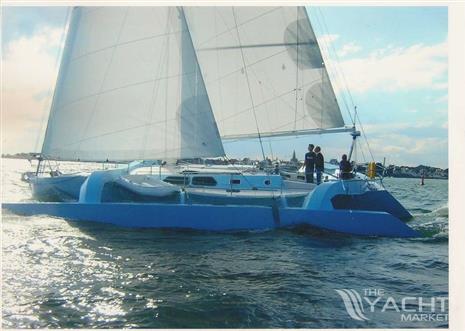
The CNA Tribellule 44.2, located in Port Saint Louis du Rhone, France, has an overall length of 13.70 metres and a beam of 9.55 metres. Manufactured in 2004, this boat features navigation equipment including radar, wind instrument, speed instrument, GPS, depth instrument, VHF, compass, and autopilot. It is rigged with a Genoa sail and comes equipped with safety essentials like a life raft and bilge pump. Additionally, it includes a battery charger among its electronics.
About this CNA CNA TRIBELLULE 44.2
- Wind Instrument
- Speed Instrument
- Depth Instrument
Safety Equipment
Electronics.
- Battery Charger
TRIMARAN en aluminium construit au chantier CN Aluminium, à voir.
Visible sur rendez vous, merci de contacter Christophe BUHOT ou Philippe FROMENT
Situé en Méditerranée sur 23 hectares , Port Navy Service, aujourd’hui plus grand port à sec européen, vous offre plus de 1500 places , 120 tonnes de capacité de levage et 35 années d’expérience à votre service.
Port Navy Service
Your message has been sent.
Contact Broker/Dealer
By submitting this form, you agree to our Privacy & Cookie Policy
Site protected by Google reCAPTCHA Privacy Policy and Terms of Service apply
CNA CNA Tribellule 44.2 also found under:
- CNA CNA Tribellule 44.2
- CNA CNA Tribellule 44.2 France
Featured articles:
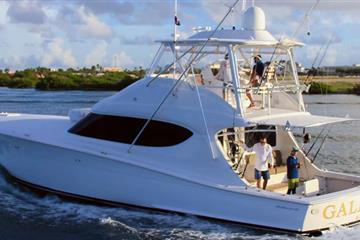
What Types of Boats Are Good for Different Types of Fishing?
There are many different types of boats that ...

Tips for Finding Better Used Boats for Sale
Buying a used boat can be a great way to save...
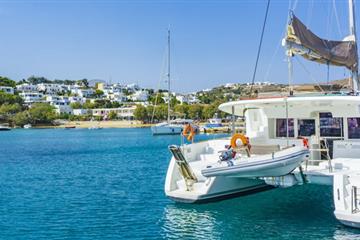
Pros and Cons of Multihull Boats vs Monohull Boats
Monohull boats are a classic type of vessel w...
More boats from this seller
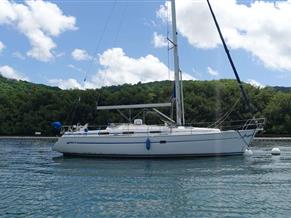
£67,066 GBP
Listed price €79,000 EUR
View details

£119,276 GBP
Listed price €140,500 EUR
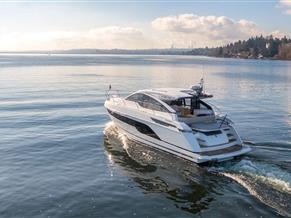
Listed price €7,000 EUR
View all 5935 boats
Ask for more photos
Email to a friend.
By submitting this form, you agree to our Privacy & Cookie PolicySite protected by Google reCAPTCHA Privacy Policy and Terms of Service apply
Report this boat
Thank you, your message has been sent.
Why not register your interest in these similar boats?
We will send the following details to the sellers of the selected boats: Your name, email address, phone number (if provided). your country and which boat(s) you are interested in.
Request More Information
Sign up to our newsletter, change units of measure.
This feature requires cookies to be enabled on your browser.
Show price in:
Show lengths, beam and draft in:
Show displacement or weight in:
Show capacity or volume in:
Show speed in:
Show distance in:


6 Best Trailerable Trimarans For Bluewater and Coastal Sailing

As an Amazon Associate, we earn from qualifying purchases. We may also earn commissions if you purchase products from other retailers after clicking on a link from our site.
Having a boat costs a lot of money, even when you are not using it, marina fees, etc. And once it is in the water most sailors never go very far from their “home marina” and sailing will be somewhat restricted. However, what if you could fold your trimaran and put it on a trailer, store it at your house, and go to a new sailing spot the next time?
Here are 6 of the best trailerable trimaran:
- The Dragonfly series
- Corsair Series
- Windrider 17
Choosing the best trailerable trimaran (a multi-hull with three “hulls”) will depend on crucial factors like speed, durability, design, and ease of transportation. This article is here to help you get started with your research and hopefully help you on the way towards your dream boat!
Table of Contents
Cruising Trimarans That Can Be Transported
Cruising boats are made for multiday sailing either on the coast of your favorite sailing area or full-out blue-water ocean crossings. Extended living should be a priority in these designs.
1. The Dragonfly 25 and 28 (Dragon Fly Series)
Dragonfly is in the business of making the “best foldable trimarans on the planet” many would agree with this statement. Dragonfly is known for its commitment to easy trailering and ease of use, shown in designs for the Dragonfly 25 and Dragonfly 28.
The “Swing Wing” system on the linchpins is one of the key features of the dragonfly series. The system’s application makes it possible for the trimaran to narrow its beam as much as 50%.
Attesting to its Scandinavian manufacturing, most parts of the trimaran are made in-house. This guarantees quality and ensures that all used parts are above standard.
You don’t need to look further than the Dragonfly 25. Its centerboard slightly offset to port. Extra space is created in the main hull’s interior with a trunk buried under a settee. Performance-wise, the low drag and narrow hull shape allow the boat to reach blistering speeds.
Dragonfly 28 In Numbers
- Length: 8.75m
- Beam folded: 2.54m
- Max crew: 5-7 people
- Max Speed: 22+knots
Dragonfly 25 In Numbers
- Length: 7.65m
- Beam folded: 2.30m
- Max crew: 4-6 people
- Max Speed: 21+knots
2. Farrier F-22
New Zealand enters the trimaran manufacturing race with this premium sea goer. The vessel comes in two different versions: a performance variation with more horsepower and a full cabin cruising version.
Compared to the dragon series the F-22 has the biggest allowance for space.
The F-22 is known for being one of the easiest trimarans to fold and load.
The sports version of the F-22 has some really good performance to offer. It has an aggressive spirit: you can mount a sail while leaving plenty of space for the boat’s fine entry and flared forward sections. The build quality is also topnotch—a lasting memorial to a principle that Ian Farrier always worked by: excellence.
Farrier F-22 In Numbers
- Length: 7.0m
- Beam folded: 2.5m
- Max crew: 3-5 people
- Max Speed: 20+knots
3. Corsair Series
This boat series has an exciting history. Farrier created it to promote his trailerable tri concept. However, the series is now independent with a top-class vehicle to its name.
The Corsair 760 is listed as providing some of the best performance and safety benefits to sailors.
Building off the spirit of excellence of the founder, the Corsair 760 has created a boat with comfort and racing potential. The boat can be tricky to handle at first, but it will be a breeze once you get the hang of it.
It is also worth noting that the corsair 37 is the largest trailerable trimaran on the market today.
Daysail Trimarans That Can Be Transported
Boats that are made for dayssailing are usually smaller, cheaper and more easily handled. They are perfect for those looking to enjoy a full day on the water in calm weather, but are usually less suitable for multiday events or rough sea sailing.
4. The Astus Models (20ft, 22.5ft, and 24ft)
If you’re looking for something small but still capable of doing day sailing, this 22.5-foot trimaran is for you. Built for speed and maneuverability, the Astus 22.5 has optional foils to optimize speed.
The modern design, coupled with the spacious interior, can fit up to four beds. Accordingly, this trimaran is suited for family outings.
The Astus brand specializes in transportable trimarans, worth noting is that some models need a specific trailer whilst the smaller boats use a standard trailer.
5. Weta 14.5
The 2019 Weta trimaran is a 14.5-foot (4.4-meter) trimaran featuring a carbon frame, centerboard, rudder foil, and rudder shock. The hull is made from fiberglass and foam. The Weta is built for strength and speed based on these lightweight materials.
The 2019 Weta trimaran is easy to sail and is worth considering whether you want to take a quiet sail, race with your friends, or take kids to a sailing lesson. It has a simple design and is easy to set up independently.
The small size makes it more suitable for daysailing in good weather rather than multiday cruising, although more experienced sailors will of course push the limits of this boat.
6. WindRider 17
The 17.4-foot (5.3-meter) WindRider 17 is one of the more versatile trimarans in the market. It packs high performance for a low cost. This trimaran has a light rotating mast to boost performance, and a full-battened mainsail optimizes visibility.
This sailboat is made from rotomolded polyethylene, which is more durable than fiberglass and demands less maintenance.
The WindRider 17 has a comfortable interior and can fit six adults. This is an ideal choice for social sailing for a couple or a family and friends. It’s easy to ride, and a shallow draft allows easy maneuverability.
What’s the Largest Trailerable Trimaran?
The largest trailerable trimaran is the Corsair 37 , this multihull is built for single-handed cruising while still maintaining the ability to comfortably seat 6 people.
The Corsair 37 provides comfort, speed, and safety. It also contains just enough space to accommodate amenities like a propane stove, a sink, and other equipment.
The vessel is designed to be a performance cruiser. It features an aluminum rotating wing mast, carbon fiber bowsprit, and premium deck hardware. The corsair can still cut through the water with ease despite its size, putting the wind in your sails.
What Is a Catamaran?
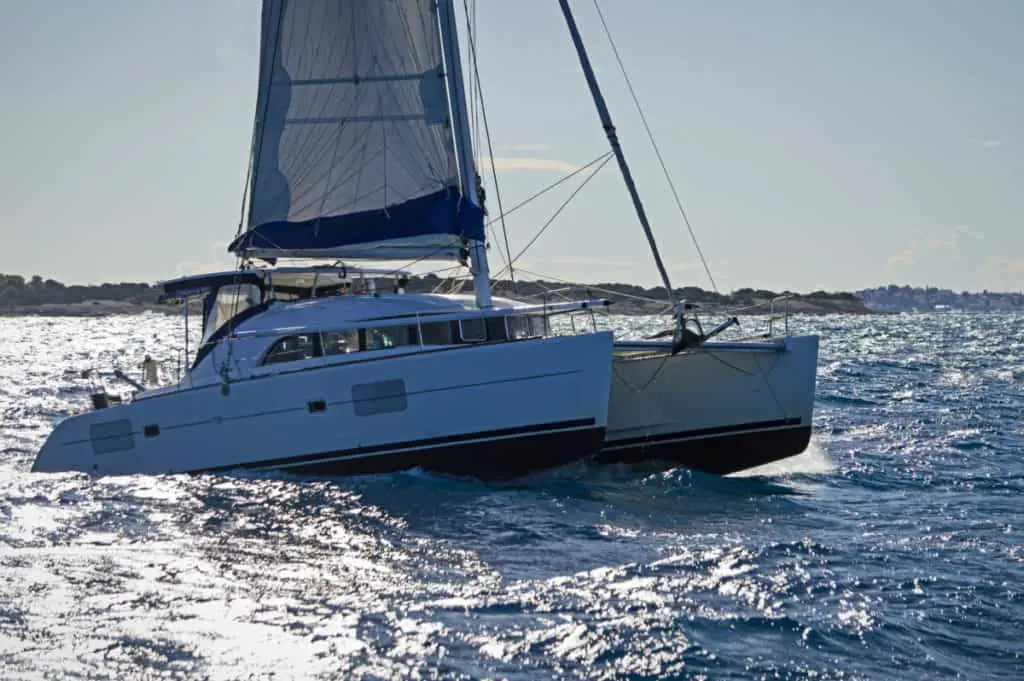
A catamaran is a boat with two hulls (a trimaran has three) connected by a bridge deck. Catamarans usually offer more space than both monohulls and trimarans of the same length. The catamaran is usually somewhat slower than a trimaran but faster than a monohull. They are usually made of fiberglass or carbon fiber.
Catamarans come in all shapes and sizes. You can find straightforward sailing catamarans, perfect for those who are only starting their sailing journey. Larger sailing catamarans have become extremely popular for long-distance sailing.
There are also power catamarans, they have huge diesel-powered engines (sometimes electric) and no sails. Also called “power cats”, these boats can reach 30+kts.
Can a Trimaran Be Trailerable?
As discussed above, some trimarans are possible to put on a trailer and move to another sailing area or to be stored at home. This is usually not possible with catamarans but is sometimes possible with the trimarans that are fitted with foldable amas (the two outer “floats” or “hulls”).
Some trimarans can be trailerable, this is mainly due to the ability to drastically decrease the vessels beam, sometimes as much as 50%. This allows the trailer plus trimaran to be below the legal requirements of the road.
Final Thoughts
It has proven difficult to beat the trimaran in terms of speed. Through the ages, this type of vessel has proven to be immensely enjoyable in all kinds of sailing activities. These can range from sea adventures to waterborne relaxation in your free time.
Trimarans come in various types, foldable, for cruising or racing, etc. However, there is a common factor: many of the small ones are trailerable. This makes them easier to move than most other types of boats.
Owner of CatamaranFreedom.com. A minimalist that has lived in a caravan in Sweden, 35ft Monohull in the Bahamas, and right now in his self-built Van. He just started the next adventure, to circumnavigate the world on a Catamaran!
Leave a Reply Cancel reply
Your email address will not be published. Required fields are marked *
Save my name and email in this browser for the next time I comment.
Recent Posts
Must-Have Boat Gear for Catamaran Sailors!
Sailing is probably the most gear-intensive activity I've ever done; there are so many decisions to be made about what gear to buy now, for tomorrow, and what to definitely never buy. The gear on...
What Kind of Boat Is The Best Liveaboard? Trawler, Monohull, or ...?
Living in a boat can be a thrilling, once-in-a-lifetime experience; however, knowing how to choose the right vessel to sustain the lifestyle you want to achieve can be crucial in making the most out...

IMAGES
COMMENTS
un tour sur le 1er modèle de la série appartenant au frère de l'architecte naval Claude Philippe
navigation sur notre Tribellule 1er du nom, flotteur au vent vue de la cabine avant vers 12/13 noeuds (partie3)
Ce vidéo présente le transport, la mise à l'eau et le mâtage du trimaran TRIBELLULE, (13,50 m de long et 9,50 m de large) dans la ville de Quimperlé (Finis...
Discover the boat review of Trimaran Tribellule , its technical specifications, and all the classified ads for a pre-owned Tribellule with Multihulls World. Tribellule :(...) 0. No item in your cart devise € $ langue. Home; ... Tribellule : radically off the beaten track
2019 ROBERTSON AND CAINE LEOPARD 45 - MATAFO IV - 3 cab Location : Port-St-Louis-du-Rhône, France Year : 2019 599 000, 00 Inc. tax€
The CNA Tribellule 44.2, located in Port Saint Louis du Rhone, France, has an overall length of 13.70 metres and a beam of 9.55 metres. Manufactured in 2004, this boat features navigation equipment including radar, wind instrument, speed instrument, GPS, depth instrument, VHF, compass, and autopilot. ... TRIMARAN en aluminium construit au ...
Essai tiré du Multicoques Mag #93 (juin/juillet 2002) Le Tribellule n'est vraiment pas un multicoques de voyage comme les autres. Tout d'abord, il s'agit d'un trimaran, et le fait est suffisamment rare pour être souligné. Ensuite, il est réalisé en aluminium. Par une journée d'automne, entre Lorient et Groix, nous sommes allés l'essayer.
Buy a CNA Tribellule 44.2 - sailing catamaran? TRIMARAN en aluminium construit au chantier CN Aluminium, à voir. Visible sur rendez vous, merci de contact...
Trilibellule 44. Le voilier Trilibellule 44 est un trimaran habitable de croisière, construit par le chantier CN Philippe. Ce voilier Dérive pivotante, gréé en Sloop en tête, réalisé par l'architecte naval Claude Philippe, mesure 13.5 m de long avec un tirant d'eau maximum de 3 m. La production a démarré en 2000. Bateau disponible d ...
used Sailboat Cna Tribellule 44.2 (2004) for sale in FRANCE (France), at the price of €65,000. used Sailboat Cna Tribellule 44.2 (2004) for sale in FRANCE (France), at the price of €65,000. ... Trimaran Total length 13.7 m . Hull colour White Beam 9.55 m . Material Aluminium Headroom 1.75 m . Displacement 7.5 t . Engines. Number of engines ...
2004 CNA YACHTING TRIBELLULE, TRIMARAN en aluminium construit au chantier CN Aluminium, à voir. Visible sur rendez vous, merci de contacter Christophe BUHOT ou Philippe FROMENT ... 2004 CNA YACHTING TRIBELLULE. £ 55,409. Port Saint Louis Du Rhone, 13 - Bouches-du-Rhône. Port Navy Service. More From This Dealer View Dealer Website. Services.
Après une visite à Rochefort auprès de l'HERMIONE, TRIBELLULE remonte vers LORIENT avec la météo capricieuse de ce mois de Mai 2013
Technical data sheet of the second-hand Sailboats for sale. Second-hand trimaran Tribellule 39 with 200 engine, 12 m in length, and 8,1 m beam length. Second-hand trimaran Tribellule 39 in Finistère (France). Sale of Sailboats reference 54565
2004 CNA YACHTING TRIBELLULE, TRIMARAN en aluminium construit au chantier CN Aluminium, à voir. Visible sur rendez vous, merci de contacter Christophe BUHOT ou Philippe FROMENT Situé en Méditerranée sur 23 hectares , Port Navy Service, aujourd'hui plus grand port à sec européen, vous offre plus de 1500 places , 120 tonnes de capacité de levage et 35 années d'expérience à votre service.
Trimaran sail trim. One of the biggest differences between a cruising monohull and a multihull is how the mainsail is trimmed. Leech tension on a yacht is often largely controlled by the kicker and the backstay, while the mainsheet sheets the mainsail in and out, predominantly controlling the angle of the boom to the centreline, and there may be a short traveller.
2004 CNA YACHTING TRIBELLULE. $ 71,010. Port Saint Louis Du Rhone, 13 - Bouches-du-Rhône. 1 ...
Maintenant l'autre côté! Le flotteur tribord sous le vent de notre cher TRIBELLULE vue du hublot de la cabine avant, la caméraman est assise dans la couchette
Un trimaran, le Tribellule, extrait des eaux de la Laïta pour être déposé sur une remorque. Destination les chantiers CNA Yachting à la Villeneuve-Braouïc. Mise à l'eau en 2000, il a besoin d'un coup de peinture et de petites réparations. Ouest-France
A medium heavy cruising aluminium catamaran is far easier to design and build. more in the abilities of aluminium factory. Two examples of totally different alu tris by Langevin, see the pics; Djebel Amour, a super luxury floating condo able to sail correctly. The building was very, very, very expensive. 16m x 9.2m.
CNA CNA TRIBELLULE 44.2; Search boats for sale. Save Share Boat ID: 2718782. CNA CNA TRIBELLULE 44.2 (2004) for sale in PORT SAINT LOUIS DU RHONE, France, France. £55,494 GBP Listed price €65,000 EUR Tax Paid / IncludedGet a foreign exchange quote. Transport It Insure It
un tour sur le 1er modèle de la série, appartenant au frère de l'architecte Claude Philippe (2ème partie)
Here are 6 of the best trailerable trimaran: The Dragonfly series. F-22. Corsair Series. Astus. Weta 14.5. Windrider 17. Choosing the best trailerable trimaran (a multi-hull with three "hulls") will depend on crucial factors like speed, durability, design, and ease of transportation.
Montée au sec du trimaran TRIBELLULE par l'élévateur de l'aire de réparation navale du port de pêche de LORIENT/KEROMAN